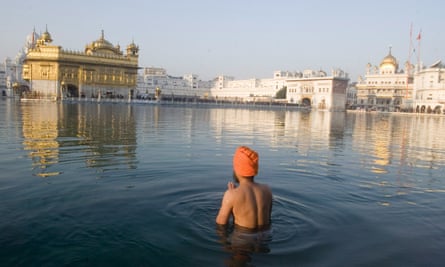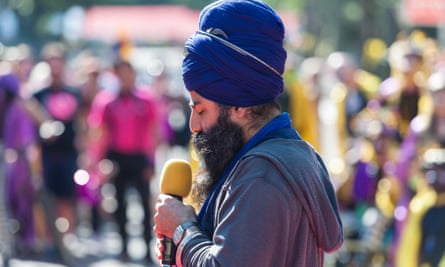Nobody knows the precise origins of the turban, although there are references to it dating back almost 4,000 years from Mesopotamia and ancient India. There is little consensus on what it should look like and how it should be worn. There is no specific colour and it can be wrapped tightly around the head or sit loosely; it can have a peak or a flat top or even be tilted, and when unfurled can measure anything up to 40 metres in length. It is a distinctive form of headdress that can be seen throughout countries in south and central Asia and north and west Africa, each of them having their own specific style and reasons for donning it.
But of all those who wear a turban, it is the Sikhs who have truly made it their own. For that they can thank Guru Gobind Singh, the 10th and last human guru of the faith, who called his followers together in April 1699 to the city of Anandpur in the north Indian state of Punjab to celebrate Baisakhi, the annual harvest festival. It was here that he formed the Khalsa (the pure), a brother- and sisterhood of baptised Sikhs and issued a number of edicts that have shaped Sikhism and made it what we know today.
Principal among these was that Sikhs were to maintain five articles of faith, referred to as the five Ks because they all begin with the letter K in Punjabi. The most distinctive one is kesh: keeping uncut hair, to be maintained in a turban. The other four are: kara, a round steel bracelet symbolising strength and integrity; kirpan, a ceremonial sword to emphasis martial strength; kanga, a small wooden comb to keep uncut hair in place and symbolising cleanliness and order; and kachhera, cotton shorts for chastity and readiness for battle.

It is kesh in a turban, however, that has become Sikhism’s most discernible symbol. To understand why Guru Gobind Singh chose this for his followers you have to delve into the faith’s history and the prevailing culture of Indian society. Sikhism was founded by Guru Nanak who was born into a Hindu family in 1469 in Punjab and emerged as the preacher of a revolutionary spiritual and temporal message that went against both Hinduism and Islam, the chief religions of India at the time. He railed in particular against the oppressive Hindu caste system, insisting that there was only one God and that all humans were equal.
The turban was already a status symbol within India, worn by spiritual teachers such as Guru Nanak (the succeeding nine Gurus also wore them), the nobility and the wealthy while long hair was an established symbol of holiness and spiritual power. So in ordering his followers to wear a turban and never cut their hair, Guru Gobind Singh was attempting not only to create a unique separate identity for ordinary Sikhs (until this time there was no way of distinguishing them from Hindus or Muslims), but to infuse them with spiritual strength and reinforce the idea that in the eyes of God they are all noble and equal.
From such beginnings, Sikhism is now the fifth largest religion in the world, with an estimated 27 million followers, the majority in Punjab. According to the 2011 census, there are 423,000 Sikhs in the UK, while significant populations are spread across other countries. But not all of them wear turbans. In fact, there are growing concerns that the majority both within Punjab and the diaspora are choosing not to, throwing up a theological debate about whether the turban is mandatory or not if you are to call yourself a Sikh. Differences can even arise within families; my father, for example, did not wear one while his brothers did.

According to the Rehat Maryada – the Sikh code of conduct that was formalised in 1945 by the Shiromani Gurdwara Parbandhak Committee, the elected governing body for the world’s gurdwaras (Sikh temples) – a Sikh is defined as one who has been baptised and wears the five Ks, “as bequeathed by the 10th Guru”. More liberal elements insist that it is a matter of personal choice and that you can be Sikh regardless of whether you have been baptised or wear a turban. Like any religion, Sikhism is divided between orthodox and unorthodox currents, and where you stand on this debate depends on how you choose to practice it.
The Sikh turban also finds itself affected by some current trends. Within Britain it is becoming increasingly popular among Sikh females to wear them, something that has not traditionally been done, – even though Guru Gobind Singh never proscribed it. And in the post-9/11 era, Sikhs have found themselves the victims of hate crimes, particularly in the United States, where their beards and turbans have caused some to think that they are Muslims, Taliban or Isis sympathisers.
Despite the challenges facing the Sikh turban, it is likely to remain the indelible hallmark of history and faith that it was intended to be.
